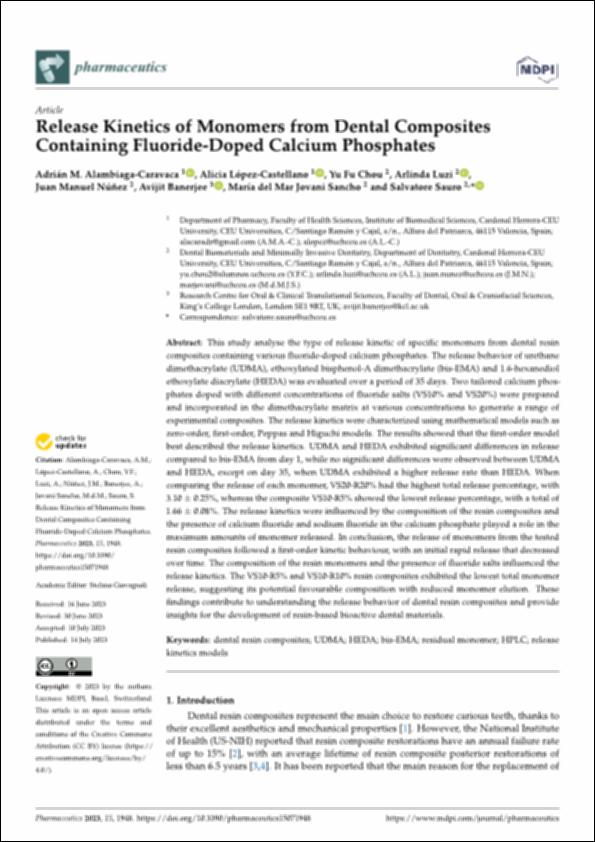Por favor, use este identificador para citar o enlazar este ítem:
http://hdl.handle.net/10637/15356Release kinetics of monomers from dental composites containing fluoride-doped calcium phosphates
| Título : | Release kinetics of monomers from dental composites containing fluoride-doped calcium phosphates |
| Autor : | Alambiaga Caravaca, Adrián Miguel López Castellano, Alicia Cristina Chou, Yu Fu Luzi Luzi, Arlinda Núñez Martí, Juan Manuel Banerjee, Avijit Jovani Sancho, María del Mar Sauro, Salvatore. |
| Materias: | Gomas y resinas; Gums and resins; Odontología; Dentistry; Adhesivos dentales; Dental adhesives; Materiales dentales; Dental materials; Farmacocinética; Pharmacokinetics |
| Editorial : | MDPI |
| Citación : | Alambiaga-Caravaca, A.M., López-Castellano, A., Chou, Y.F., Luzi, A., Núñez, J.M., Banerjee, A., Jovani Sancho, M.D.M. & Sauro, S. (2023). Release kinetics of monomers from dental composites containing fluoride-doped calcium phosphates. Pharmaceutics, vol. 15, i. 7, art. 1948 (14 jul.). DOI: https://doi.org/10.3390/pharmaceutics15071948 |
| Resumen : | This study analyse the type of release kinetic of specific monomers from dental resin composites containing various fluoride-doped calcium phosphates. The release behavior of urethane dimethacrylate (UDMA), ethoxylated bisphenol-A dimethacrylate (bis-EMA) and 1.6-hexanediol ethoxylate diacrylate (HEDA) was evaluated over a period of 35 days. Two tailored calcium phosphates doped with different concentrations of fluoride salts (VS10% and VS20%) were prepared and incorporated in the dimethacrylate matrix at various concentrations to generate a range of experimental composites. The release kinetics were characterized using mathematical models such as zero-order, first-order, Peppas and Higuchi models. The results showed that the first-order model best described the release kinetics. UDMA and HEDA exhibited significant differences in release compared to bis-EMA from day 1, while no significant differences were observed between UDMA and HEDA, except on day 35, when UDMA exhibited a higher release rate than HEDA. When comparing the release of each monomer, VS20-R20% had the highest total release percentage, with 3.10 ± 0.25%, whereas the composite VS10-R5% showed the lowest release percentage, with a total of 1.66 ± 0.08%. The release kinetics were influenced by the composition of the resin composites and the presence of calcium fluoride and sodium fluoride in the calcium phosphate played a role in the maximum amounts of monomer released. In conclusion, the release of monomers from the tested resin composites followed a first-order kinetic behaviour, with an initial rapid release that decreased over time. The composition of the resin monomers and the presence of fluoride salts influenced the release kinetics. The VS10-R5% and VS10-R10% resin composites exhibited the lowest total monomer release, suggesting its potential favourable composition with reduced monomer elution. These findings contribute to understanding the release behavior of dental resin composites and provide insights for the development of resin-based bioactive dental materials. |
| URI : | http://hdl.handle.net/10637/15356 |
| Derechos: | http://creativecommons.org/licenses/by/4.0/deed.es Open Access |
| ISSN : | 1999-4923 (Electrónico) |
| Fecha de publicación : | 14-jul-2023 |
| Centro : | Universidad Cardenal Herrera-CEU |
| Aparece en las colecciones: | Dpto. Farmacia |
Los ítems de DSpace están protegidos por copyright, con todos los derechos reservados, a menos que se indique lo contrario.


